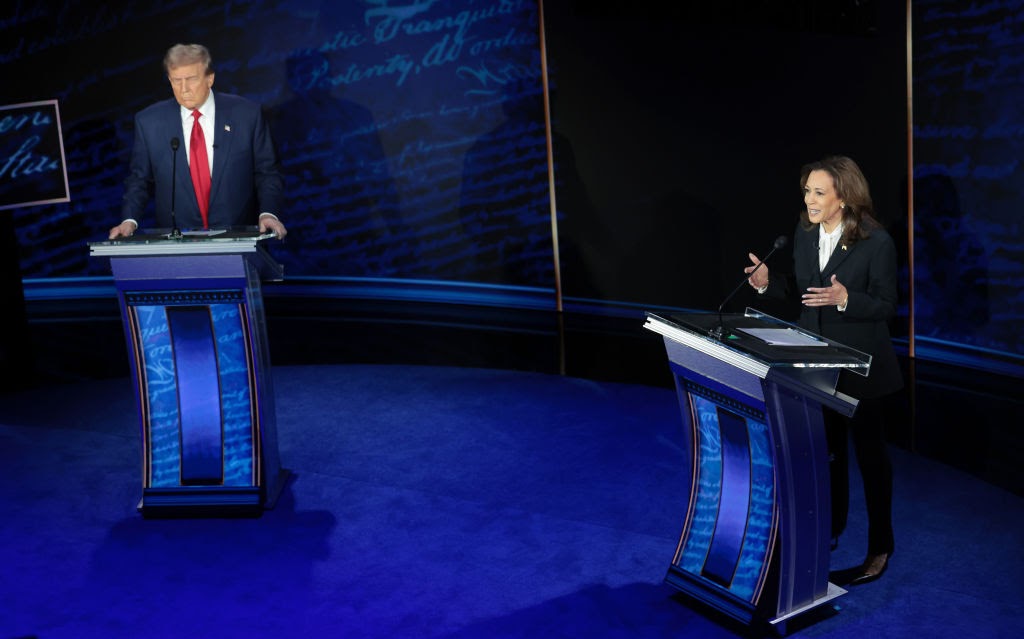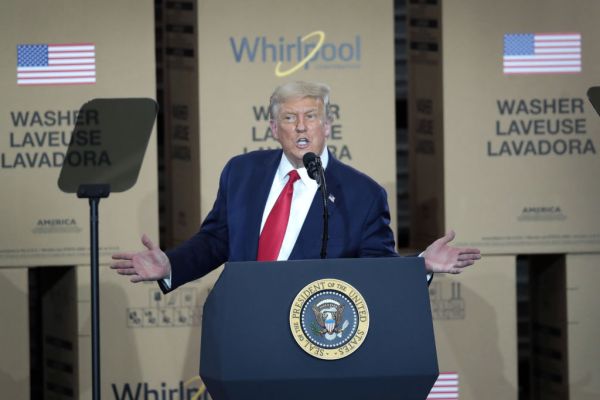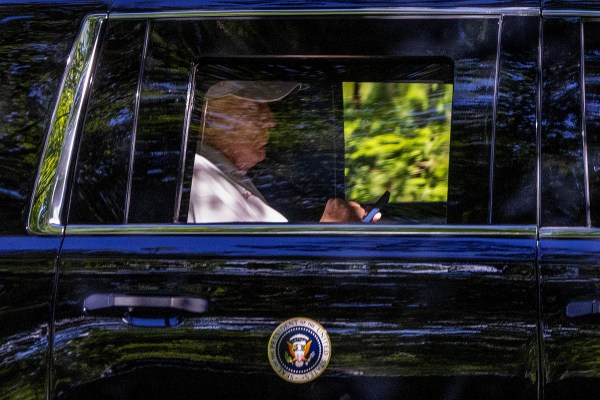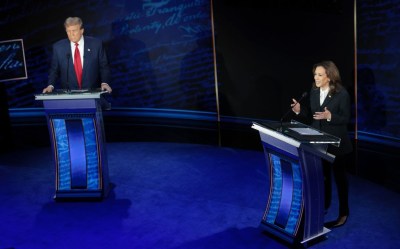Kamala Harris and Donald Trump met in Philadelphia Tuesday night in a wide-ranging debate that touched on the economy, abortion, foreign affairs, electoral integrity, and the law. While seeing each other in person was new for both candidates—the two had never met before last night—both fell back on old talking points, some of which were more true than others.
Here is a breakdown of claims from both candidates on the most important topics of the night.
Trump on the Economy
In response to a question about whether Americans could afford the higher prices caused by tariffs, Trump asserted that American consumers wouldn’t be the ones on the financial hook for his aggressive trade policies. “They aren't gonna have higher prices,” Trump said. “Who’s gonna have higher prices is China and all of the countries that have been ripping us off for years.”
Trump’s claim that Americans wouldn’t face higher prices because of tariffs is false. The Dispatch Fact Check reported on the impact of Trump’s tariff policy last year:
Tariffs—which are taxes imposed on goods and services imported from other countries—are paid directly by U.S. businesses that purchase from abroad. While the added costs of these tariffs are theoretically distributed among the buyer, seller, and consumer, economic research into U.S. tariffs has found that almost all of this added cost is passed onto domestic producers and consumers.
“For most, if not almost all commodities, when a tariff is placed on imports of the commodity (for example, steel or refrigerators) the price for the commodity paid by consumers goes up, not always by the full amount of the tariff, but usually by most of the amount of the tariff,” Vincent Smith, economist and director of Agricultural Policy Studies at the American Enterprise Institute, told The Dispatch Fact Check. “Domestic producers facing import competition then benefit from those higher prices but all consumers in the country bear a cost.”
American consumers experienced this cost as a result of Trump’s 2018 tariffs. Research from economists at the University of Chicago’s Becker Friedman Institute found that the price of washing machines and dryers rose nearly 12 percent after import tariffs were imposed. “It was no accident that once the Trump administration imposed tariffs on imports of kitchen appliances and washers and dryers, the prices of those commodities in stores like Lowes and Home Depot jumped by between $50 and $100 for appliances of modest quality, and more for higher end appliances,” Smith explained.
Trump also claimed that his tariffs raised billions of dollars for the country. “I took in billions and billions of dollars, as you know, from China,” he said.
While it is true that the federal government raised billions through duties assessed to importers under Trump, most of the cost was borne by U.S. taxpayers. According to research by the Tax Foundation, approximately $233 billion in tax revenue was collected from trade war tariffs introduced between 2017 and March 2024. Of that revenue, approximately $89.1 billions was collected during Trump’s first term, while $144.3 billion has been collected under Biden. The Tax Foundation estimates that the tariffs “amount to an average annual tax increase on U.S. households of $625.”
Trump went on to criticize Biden and Harris for inflationary pressure in the U.S. economy. “We have inflation like very few people have ever seen before. Probably the worst in our nation's history. We were at 21 percent,” Trump said. “I had no inflation, virtually no inflation, they had the highest inflation, perhaps in the history of our country because I've never seen a worse period of time,” he added later in the debate.
Trump’s claim that inflation under Biden is the worst in U.S. history is false. The U.S. inflation rate did grow substantially during the first half of Biden’s presidency, but not to the highest levels in the country’s history.
When Biden took office in January 2021, the 12-month change in the U.S. Consumer Price Index (CPI)—a common method of measuring inflation—was 1.4 percent. By June 2022, CPI had risen to 9.1 percent, the highest rate since 1980, when it reached nearly 14 percent during a period now referred to by economists as the “Great Inflation.” The highest 12-month change in U.S. CPI ever recorded, however, was measured at 17.8 percent in 1917.
Trump also claimed that the Biden administration inherited an economy that had already largely recovered from the COVID-19 pandemic. “We handed them over a country where the economy and where the stock market was higher than it was before the pandemic came in,” Trump said.
The claim is partly true. Prior to the COVID-19 pandemic, the S&P 500 index—which measures the performance of 500 of the largest companies listed on U.S. stock exchanges—peaked at approximately 3,380. During the early months of the pandemic, the index fell to a low near 2,300 but recovered to more than 3,800 by the time Trump left office in January 2021.
U.S. gross domestic product (GDP)—a measure of national economic output—also recovered to pre-pandemic levels by the time Biden took office. However, other measures of economic health, such as the unemployment rate, did not bounce back as quickly. In the first two months of the pandemic, the U.S. unemployment rate rose from 3.5 percent to a high of nearly 15 percent. By the time Biden entered office, the unemployment rate had recovered, but only to 6.2 percent—almost double the pre-pandemic rate.
Harris on the Economy
Like Trump, Harris made several dubious economic claims during the debate. Early on, Harris claimed that Trump left the American people with the worst unemployment rate in modern history. “Let’s talk about what Donald Trump left us,” she said. “Donald Trump left us the worst unemployment since the Great Depression.”
The claim is partly false. During the early months of the COVID-19 pandemic, the U.S. unemployment rate jumped from 3.5 percent in February 2020 to 14.8 percent by April 2020. While this is the highest single-month rate recorded since at least 1948, when the modern unemployment measure was adopted, the rate dropped to 6.2 percent by the time Trump left office. The unemployment rate has been higher than 6.2 percent for many periods in modern American history, including the early and late 1950s, most of the 1970s and 1980s, and during the 2008 financial crisis.
The U.S. trade deficit during Trump’s presidency was another target of Harris’ attacks. “Well, let’s be clear that the Trump administration resulted in a trade deficit, one of the highest we’ve ever seen in the history of America,” Harris said.
This claim is false. Annual deficits were lower under Trump than under Biden, and the highest monthly trade deficit ever occurred under Biden as well.
During Trump’s four years in office, the U.S. recorded annual trade deficits of between $516.9 and $653.7 billion—similar to those recorded during the presidencies of Barack Obama and George W. Bush. The U.S. recorded annual trade deficits of $848.1 billion, $944.8 billion, and $784.9 billion in 2021, 2022, and 2023 respectively—the three highest annual deficits ever recorded. In March 2022, the U.S. recorded a monthly trade deficit of $101.9 billion, the highest monthly deficit ever recorded, according to the Bureau of Economic Analysis.
On the topic of their future agendas, Harris criticized Trump for wanting to cut taxes for wealthy Americans and add even further to the federal deficit. “His plan is to do what he has done before, which is to provide a tax cut for billionaires and big corporations, which will result in $5 trillion to America's deficit,” Harris said.
This claim is mostly true but lacks some context. The Dispatch Fact Check reported on an almost identical claim from Harris last month:
Trump has advocated for extending the Tax Cuts and Jobs Act (TCJA) his administration passed in 2017 and that is set to expire in 2025. According to an analysis from the Congressional Budget Office, extending tax provisions in the TCJA would cost approximately $4.6 trillion, including interest, over the next decade. Similarly, the Committee for a Responsible Federal Budget—a nonpartisan, nonprofit fiscal policy think tank—projected TCJA extensions would cost $4.5 trillion over the next decade.
However, those tax breaks do not apply exclusively to billionaires or high-income earners, but apply to individuals across various income levels. The projections also include costs from extending estate, business, and other TCJA provisions—not just those for individual taxpayers.
Harris was also misleading in a claim about job creation numbers. “We have created over 800,000 new manufacturing jobs while I have been vice president,” she said.
The claim is close to being true—Harris overestimated slightly—but it misrepresents actual job growth during the Trump and Biden presidencies. According to the U.S. Bureau of Labor Statistics, since Biden and Harris took office, total U.S. manufacturing employment has risen by approximately 739,000. However, these gains are mostly attributable to the recovery of temporary job losses sustained during the COVID-19 pandemic. Since February 2020, the month before the COVID-19 pandemic began, manufacturing employment has grown only by approximately 147,000. During the first three years of Trump’s presidency, by comparison, the U.S. economy gained approximately 419,000 manufacturing jobs.
Trump on Abortion
Like the economy, abortion was another flashpoint for both candidates throughout the debate.
When asked about his support for a six-week abortion ban in Florida, and whether women should trust him on the abortion issue, Trump made reference to claims that Ralph Northam, the former Democratic governor of Virginia, had expressed support for abortion even after birth. “[Northam] said the baby will be born and we will decide what to do with the baby,” Trump remarked. “In other words, we’ll execute the baby.”
Trump’s statement leaves out that Northam was speaking specifically about nonviable infants or infants with severe genetic abnormalities, and the suggestion that babies would be executed is false.
In a 2019 interview with the radio station WTOP, Northam was asked whether he supported eliminating restrictions on third-trimester abortions. In part of his response, Northam described a scenario in which a nonviable fetus was delivered during labor. “If a mother is in labor, I can tell you exactly what would happen,” Northam says. “The infant would be delivered, the infant would be kept comfortable, the infant would be resuscitated if that’s what the mother and the family desired. And then a discussion would ensue between the physicians and the mother.”
Trump followed up with a similar assertion against Minnesota Gov. Tim Walz, the Democratic nominee for vice president. “But her vice presidential pick says abortion in the ninth month is absolutely fine,” Trump said. “He also says execution after birth … is okay.”
Walz did sign legislation in Minnesota that had no restrictions against abortions in the ninth month of pregnancy. However, there is no evidence that Walz supports killing fetuses after birth—an act that is illegal in all 50 states. The Dispatch Fact Check reported on Minnesota’s abortion regulations last month:
Earlier in 2023, Walz signed legislation enshrining the right to abortion into Minnesota law following the Supreme Court’s reversal of Roe v. Wade. The new statute established that “Every individual who becomes pregnant has a fundamental right to … obtain an abortion,” and did not include any restrictions or prohibitions. Minnesota currently has no statutory limits on abortion at any stage of pregnancy.
We noted in our fact check that eight infants had died after being born alive during Walz’s term as governor. Three were pre-viable, two had fetal anomalies, and three were given “comfort care.”
Continuing on the topic of abortion, Trump claimed that legal experts universally supported the Supreme Court's decision to overturn Roe v. Wade. “Every legal scholar, every Democrat, every Republican, liberal, conservative, they all wanted this issue to be brought back to the states where the people could vote,” Trump said. “And that’s what happened.”
While many legal scholars did believe that Roe v. Wade was wrongfully decided, the view was far from universal. In April, for example, CNN reported on several legal scholars who opposed the Supreme Court’s decision to overrule Roe in June 2022. “Most legal scholars probably track most Americans who didn’t want to overturn Roe,” Mary Ziegler, a law professor at the University of California, Davis, told CNN in an interview at the time. “It wasn’t as if legal scholars were somehow outliers,”
Harris on Abortion
Taking her own swing at the abortion issue, Harris claimed that many states in the country subject women to unduly restrictive abortion regulations. “In over 20 states there are Trump abortion bans which make it criminal for a doctor or nurse to provide health care,” Harris said. “In one state it provides prison for life.”
Harris’ claim is partially true, but missing context. While many abortion restrictions have been implemented at the state level since Roe v. Wade was overturned in 2022, Trump—who was not serving in any public office at the time—had no role in creating or proposing state abortion bans. Across the country, 31 states have specified gestational limits on abortion, while 22 states have implemented abortion policies that are more restrictive than Roe v. Wade’s viability standard (approximately 24 weeks). Two additional states—Montana and Wyoming—passed laws restricting abortion access that were eventually blocked by courts.
Harris’ claim that one state holds offenders accountable with prison-for-life punishment holds some truth, but is also missing context. Passed in March 2021, Texas’ heartbeat abortion law prohibits abortions except in situations of a “medical emergency,” which it defines as a “life-threatening physical condition aggravated by, caused by, or arising from a pregnancy that, as certified by a physician, places the woman in danger of death or a serious risk of substantial impairment of a major bodily function unless an abortion is performed.” Under the law, anyone who performs an abortion could face first-degree felony charges if the abortion is successful, a punishment that can carry a life sentence. While Harris is technically correct that the state “provides prison for life,” Texas has not actually prosecuted any physicians for performing abortion under the law.
Harris also claimed that Trump would seek to implement harsh abortion restrictions on the federal level if elected in November. “If Donald Trump were to be re-elected, he will sign a national abortion ban,” Harris said. This claim is false, at least according to Trump himself. The former president has publicly opposed federal laws restricting abortion access, preferring abortion policy to be instead determined state-by-state. “My view is now that we have abortion where everybody wanted it from a legal standpoint, the states will determine by vote or legislation or perhaps both,” Trump said in an April video message. “Many states will be different. Many will have a different number of weeks, or some will be more conservative than others. … At the end of the day, this is all about the will of the people.”
The vice president also targeted abortion policy proposals presented by Project 2025—a public policy blueprint organized by the conservative Heritage Foundation. “Understand in his Project 2025 there would be a national monitor that would be monitoring your pregnancies, your miscarriages.”
Harris’ claim is partially correct. The Centers for Disease Control and Prevention (CDC) already maintains a reporting system for miscarriages and abortion—though not pregnancies, as Harris claimed. States are not currently required to participate in the reporting system. Three states—California, New Jersey, and New Hampshire—declined to share abortion statistics with the CDC in the most recent publicly available report, released in 2021. However, as The Dispatch Fact Check reported previously, Project 2025’s proposal calls for an overhaul of the CDC’s existing system.
Project 2025 calls for a substantial upheaval of the reporting program. “Because liberal states have now become sanctuaries for abortion tourism, HHS should use every available tool, including the cutting of funds, to ensure that every state reports exactly how many abortions take place within its borders, at what gestational age of the child, for what reason, the mother’s state of residence, and by what method,” Project 2025 proposed.
Continuing on the topic of abortion, Harris made a mostly true claim about the success—or lack thereof—of recent abortion-related referendums. “The majority of Americans believe in a woman’s right to make decisions about her own body,” Harris said. “And that is why in every state where this issue has been on the ballot, in red and blue states both, the people of America have voted for freedom.”
Since Roe v. Wade was overturned in 2022, voter referendums on abortion policy have appeared on seven state ballots, all of which resolved in favor of the pro-choice side. In Montana, a ballot measure that sought to increase protections for survivors of failed abortion attempts lost by a narrow 5-point margin. In three instances, voters passed measures that guaranteed access to abortion procedures. In the other three attempts, voters rejected measures that would have imposed additional restrictions.
Trump on Foreign Affairs
With domestic controversies in the rearview, the debate’s moderators turned their attention to the candidates’ positions on foreign policy and international affairs.
In response to a question about whether he wanted Ukraine to win its war against Russia, Trump criticized Biden and Harris for not making European countries pay their fair share to support Ukraine. “Look, we’re in for $250 billion or more because [Biden and Harris] don’t ask Europe, which is a much bigger beneficiary to getting this thing done than we are,” Trump said. “They’re in for $150 billion less because Biden and you don’t have the courage to ask Europe like I did with NATO. … They should be forced to equalize.”
Trump’s claim is false: Europe has collectively provided more aid to Ukraine than the U.S., both in absolute terms and as a percentage of GDP.
According to the Kiel Institute for the World Economy’s Ukraine Support Tracker, as of June 2024, the U.S. has provided approximately $83 billion in aid to Ukraine. Comparatively, European countries—meaning all EU member states plus the United Kingdom, Norway, Iceland, and Switzerland—have allocated approximately $122 billion in collective aid to Ukraine. U.S. contributions amount to only 0.347 percent of GDP, less than most Western, Northern, and Eastern European countries.
Trump also criticized Harris and Biden for their “incompetently handled” withdrawal of U.S. forces from Afghanistan in 2021. “We would have been out faster than them, but we wouldn’t have lost the soldiers. We wouldn’t have left many Americans behind,” Trump said. “And we wouldn’t have left, we wouldn’t have left $85 billion worth of brand new beautiful military equipment behind.”
Trump’s claim that the U.S. left $85 billion worth of new military equipment in Afghanistan is false.
The number cited by Trump likely comes from a 2021 report by the Special Inspector General for Afghanistan Reconstruction in which congressional appropriations to the Afghan National Defense and Security Forces (ANDSF) were estimated to total more than $83.1 billion between 2005 and 2021. These appropriations, however, did not only pay for equipment. Rather, they were used to fund various parts of the ANDSF for more than 15 years.
In April 2022, CNN reported that a Department of Defense report had determined that approximately $7 billion in military equipment had actually been left behind during the withdrawal. The abandoned equipment included aircraft, munitions, and communications devices supplied to the ANDSF between 2005 and 2021. While this still represents a substantial amount of surrendered military hardware, it is far less than the $85 billion claimed by Trump and importantly did not include any equipment used by U.S. forces.
Trump went on to criticize Harris for her lack of support for Israel. “She wouldn’t even meet with Netanyahu when he went to Congress to make a very important speech,” he said. “She refused to be there because she was at a sorority party of hers. She wanted to go to the sorority party. She hates Israel.”
Trump’s claim is partly true, but is missing context. Harris did miss a speech that Netanyahu gave to Congress but it is not true that refused to meet with the Israeli leader.
In July, Netanyahu arrived in the U.S. to speak with lawmakers about Israel’s ongoing war against Hamas in Gaza. Harris, who had only days earlier announced her candidacy for the Democratic presidential nomination, did not preside over the Israeli prime minister’s joint address to Congress, instead choosing to speak at an Indianapolis convention for Zeta Phi Beta, a historically black sorority. Harris, however, did meet with Netanyahu in Washington, D.C., the following day, telling reporters she had a “frank and constructive” conversation with him.
Harris on Foreign Affairs
Harris took an equally critical aim at Trump’s foreign policy record. In one instance, she attacked the Doha Accords—an agreement formed between the U.S. government and the Taliban during the Trump administration. “He negotiated directly with a terrorist organization called the Taliban,” Harris said. “The negotiation involved the Taliban getting 5,000 terrorists, Taliban terrorists released.”
Harris’ claim is true: The Doha Accords included a provision that released up to 5,000 Taliban fighters detained by Afghanistan’s government in exchange for the release of 1,000 people imprisoned by the Taliban.
“The president at the time invited the Taliban to Camp David,” Harris added to her critique. This claim is true, but is missing context. In 2019, Trump privately invited Taliban leaders to Camp David—the Maryland retreat that U.S. presidents have used as a diplomacy hub since World War II—in an attempt to finalize negotiations that would later become the Doha Accords. However, after the Taliban claimed responsibility for an attack that killed an American service member, Trump withdrew the Taliban’s invitation.
When addressing the foreign policy record of the Biden-Harris administration, Harris commented on the current operations of U.S. military service members. “As of today, there is not one member of the United States military who is in active duty in a combat zone in any war zone around the world, the first time this century,” she said.
This claim is false and misleading. The U.S. has active military operations in several countries in the Middle East, including about 900 soldiers in Syria and 2,500 in a few locations in Iraq. In January, three U.S. Army reservists—not active-duty personnel—were killed in an enemy drone strike while stationed in Jordan, according to the Defense Department’s Defense Casualty Analysis System. Even more recently, seven U.S. soldiers sustained non-critical injuries late last month in a joint military operation with the Iraqi military, targeting ISIS terrorist fighters in western Iraq.
Elections and the Law
After Trump refused to acknowledge that he had lost the 2020 election, ABC News moderator David Muir remarked that Trump’s team had lost 60 cases related to electoral fraud claims. In response, Trump argued that he had lost only on standing. “They said we didn’t have standing, a technicality,” Trump said. “Can you imagine a system where a person in an election doesn’t have standing, the president of the United States doesn’t have standing?”
Trump’s claim is mostly false. Trump’s legal team filed 62 lawsuits disputing the results of the 2020 election. Of these, 31 were dismissed due to a lack of standing, according to the House Select Committee to Investigate the January 6 Attack on the United States Capitol’s final report. Of the remaining 31 cases, 30 were dismissed after evidentiary hearings, and one case was won. That single victory—which “affected relatively few votes, did not vindicate any underlying claims of fraud, and would not have changed the outcome in Pennsylvania,”as the January 6 Committee report noted—was eventually overturned by the Supreme Court of Pennsylvania.
Trump’s remarks did not end at his own lawsuits: He also made claims regarding President Joe Biden’s classified documents investigation. “By the way, Joe Biden was found essentially guilty on the documents case,” Trump said.
This claim is false, but it warrants some explanation. U.S. Justice Department special counsel Robert Hur, who was investigating Biden’s handling of classified government documents, ultimately declined to pursue prosecution against Biden. While Hur cited Biden’s advanced age as a contributing factor to his decision—explaining a jury might perceive the president as a “sympathetic, well-meaning, elderly man with a poor memory”—he premised his decision on the grounds that there was insufficient evidence of criminal wrongdoing to pursue prosecution. “We conclude that the evidence does not establish Mr. Biden’s guilt beyond a reasonable doubt,” Hur’s report stated.
Harris made a similarly dubious legal claim late in the debate. “The United States Supreme Court recently ruled that the former president would essentially be immune from any misconduct if he were to enter the White House again,” Harris said.
Harris’ claim—that the Supreme Court’s ruling in Trump v. United States issued in early July would grant him immunity from any misconduct—is false and a misinterpretation of the Supreme Court’s decision. As we explained in a previous Dispatch Fact Check:
The Supreme Court ruled in Trump v. the United States that executive authority partially shields the president from criminal prosecution. The court found that presidents have full immunity when exercising authority explicitly granted to them in the U.S. Constitution, “presumed” immunity for official presidential acts, and no immunity for unofficial acts.
What does this mean in practice? That answer is not fully clear and would likely require further deliberation from the courts. “There is no question that the Supreme Court’s opinion will make it more difficult to prosecute both Donald Trump and future presidents,” Michael Warren and Sarah Isgur wrote in The Collision. “But the question will be how strong this new presumption of immunity is and where the courts draw the line on the ‘outer perimeter’ of a president’s official acts.”
Here are a few miscellaneous claims:
People Are Eating Pets?
Rest assured, animal lovers of Springfield, Ohio—migrant residents have not been stealing and eating pets, despite Trump claiming the opposite. “In Springfield, they’re eating the dogs,” Trump said. “The people that came in. They’re eating the cats. They’re eating—they’re eating the pets of the people that live there. And this is what’s happening in our country.”
These claims are false. On Monday, Springfield officials confirmed that online rumors that Haitian immigrants were stealing and eating pets in the town were unfounded. “In response to recent rumors alleging criminal activity by the immigrant population in our city, we wish to clarify that there have been no credible reports or specific claims of pets being harmed, injured or abused by individuals within the immigrant community,” the city’s strategic engagement manager, Karen Graves, said in a statement.
The Dispatch Fact Check initially reported on the story Tuesday afternoon before Trump’s debate comments:
The most recent police blotter from the Springfield News-Sun shows that 20 people were indicted in Clark County last week, but mostly on drug charges or for theft or robbery. While there were no incidents of pet-eating or other forms of animal abuse in Springfield, Ohio, there was a recorded cat abuse-related incident in the state late last month—more than 150 miles away in Canton. According to the report, law enforcement arrested a 27-year old woman accused of killing and eating a cat in a residential neighborhood. Critically, there is no indication that the suspect was an immigrant.
Harris and Bail Funds
Trump also targeted Harris’ support for a nonprofit bail fund in 2020, amid her first presidential bid. “She went out in Minnesota and wanted to let criminals that killed people, that burned down Minneapolis,” Trump said. “She went out and raised money to get them out of jail.”
This claim is partially true, but missing context. Less than a week after the death of George Floyd, then-Sen. Kamala Harris shared a donation link for the Minnesota Freedom Fund—an anti-bail organization that covered bail expenses for detainees, including those arrested while protesting George Floyd’s death at the hands of a Minnesota police officer. “If you’re able to, chip in now to the Minnesota Freedom Fund to help post bail for those protesting on the ground in Minnesota,” she tweeted in June 2020. Harris’ tweet was the only association the vice president had with the Minnesota Freedom Fund, the organization later said. The group also said that Harris never donated herself. However, the organization did pay bail for several suspects accused of serious crimes including attempted murder, physical assault, and looting, the Washington Post reported in September 2020. “We do not make determinations of bail support based on the crimes that individuals are alleged to have committed,” the organization’s then-director, Greg Lewin, said at the time.
Harris and ‘Bloodbath’
Harris said, after addressing the events of January 6, 2021, that “Donald Trump the candidate has said in this election there will be a bloodbath, if this—and the outcome of this election is not to his liking.”
Trump did use that term—as he acknowledged to Harris moments later—at a rally in March, but he was referring to the economic consequences of a Democratic victory in November, after vowing to apply tariffs to cars made in Mexico were he to win:
We’re going to put a 100% tariff on every single car that comes across the line, and you’re not going to be able to sell those cars if I get elected. Now if I don’t get elected, it’s going to be a bloodbath for the whole — that’s gonna be the least of it. It’s going to be a bloodbath for the country. That will be the least of it. But they’re not going to sell those cars.
If you have a claim you would like to see us fact check, please send us an email at factcheck@thedispatch.com. If you would like to suggest a correction to this piece or any other Dispatch article, please email corrections@thedispatch.com.








Please note that we at The Dispatch hold ourselves, our work, and our commenters to a higher standard than other places on the internet. We welcome comments that foster genuine debate or discussion—including comments critical of us or our work—but responses that include ad hominem attacks on fellow Dispatch members or are intended to stoke fear and anger may be moderated.
With your membership, you only have the ability to comment on The Morning Dispatch articles. Consider upgrading to join the conversation everywhere.